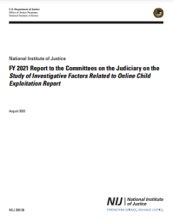Child (under 12)
Development of a model to predict 3D femur morphology in infants and young children
DENTAGE: A multi-component subadult dental age estimation method
Improving Outcomes for Child Sex Trafficking Victims, Phase 2: A Rigorous Outcome Evaluation of Love146’s Long-Term Services (LTS) Program
Centering Youth Experiences to Address Community Violence: A Youth Participatory Action Research Project
Identifying Successes and Barriers in a Child Advocacy Center: An Examination of Five Service Areas
Investigating Impulsivity as a Root Cause of School Violence: A Systematic Review and Meta-Analysis
Resiliency Against Victimization: Results From the National Longitudinal Study of Adolescent Health
Safe Transitions for Teens: Assessing the Impact of Intimate Partner Transitional Housing on Adolescent Residents
The Missouri Prevention Center: A Multidisciplinary Approach to Reducing the Societal Prevalence and Burden of Youth Mental Health Problems
Teacher Recognition, Concern, and Referral of Children's Internalizing and Externalizing Behavior Problems
Exposing School Employee Sexual Abuse and Misconduct: Shedding Light on a Sensitive Issue
Practices and Policies Around Wellness: Insights From the Internet Crimes Against Children Task Force Network
FY 2021 Report to the Committees on the Judiciary on the Study of Investigative Factors Related to Online Child Exploitation Report
Measurement and Analysis of Child Pornography Trafficking on P2P Networks
What's Possible with Rapid DNA Technology?
NIJ scientist Tracey Johnson joins science writer Sarah Michaud in this episode. They discuss Rapid DNA technology, and Tracey explains the complexities of this technology – its pitfalls and its possibilities.
Reading and Resources from NIJ:
Developing Knowledge about What Works for Make Schools Safe: Implementation and Evaluation of Tools for Life in Jackson Public School District in Mississippi
A Multiple Perspectives Analysis of the Influences on the School to Prison Pipeline in Virginia: Report of Quantitative Findings
The Effect of Impact Angle and Fall Height on Skull Fracture Patterns in Infants
The Cycle of Violence: Abused and Neglected Girls to Adult Female Offenders
The role of psychiatric symptoms and environmental vulnerability factors in explaining the relationship between child maltreatment and suicidality: A prospective investigation
Tribal Crime, Justice, and Safety, Part 2
Stacy Lee Reynolds and Christine (Tina) Crossland continue their discussion of tribal crime, justice, and safety, including how Native American persons experience crime victimization at higher rates than non-Native people and the jurisdictional complexities in responding to tribal crime, justice, and safety. Read the transcript.
Listen to the first half of Stacy and Tina’s discussion.
Reading and Resources from NIJ
Tribal-Researcher Capacity Building Grants






